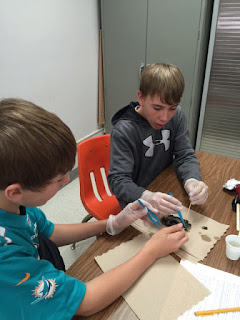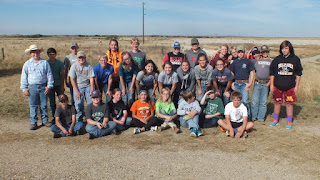In order to extend our story and make a connection with real life, we decided to "be Ben" and learn a little more about birds of prey. In order to do that we dissected barn owl pellets. Owls eat their food in chunks or whole. Any soft tissues are dissolved in the abdomen and used for nutrition, the fur and bones, unable to be dissolved are then compacted by the gizzard and regurgitated by the owl about 12 hours after having their meal. These owl pellets are then dried, sterilized to remove any bacteria or creepy crawlies, and can be examined and dissected to learn more about the owl's diet.
In our dissections, the students found a lot of fur, small bird feathers and too many bones to count. There were numerous intact skulls, jawbones, teeth, ribs, vertebrae, long bones, etc... It was quite exciting to be the person to come across another skull or the first one to identify a vertebrae. After a student found a bone, they then sorted them on a bone diagram in order to classify them and try to determine what type of animal the skeleton used to be.
We decided so far that most of the skulls look like they belonged to small field mice but one group thinks that they found part of a bird.
Even though the bones were teeny tiny, it was even possible to see the ball at the end of the thigh bone that would attach into the hip socket.
If you would like to find out a little bit more about owl pellets and see one being regurgitated you can follow these links in order to hear a catchy Owl Pellet tune or see a video of a









































